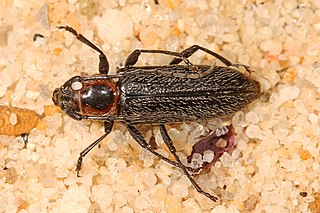
Attagenus is a genus of beetles. This genus is found in tropical Africa, the Palearctic including Europe, the Near East, the Nearctic, North Africa and East Asia. There are nearly 200 species. The genus has existed for at least 99 million years, with fossils known from the Cenomanian aged Burmese amber and Turonian aged New Jersey amber.

Mylabris is a genus of beetles in the family Meloidae. It is endemic to the Palearctic realm. The species-rich genus Hycleus was historically confused with Mylabris and have their greatest diversity in the Afrotropics.

Drilus is a genus of beetles belonging to the family Elateridae.

Stenosphenus is a genus of beetles in the family Cerambycidae, containing the following species:

Saperdini is a tribe of longhorn beetles of the subfamily Lamiinae.

Phytoecia is a genus of longhorn beetles of the subfamily Lamiinae,
Phytoecia astarte is a species of beetle in the family Cerambycidae. It was described by Ganglbauer in 1885. It is known from Syria, Lebanon, Azerbaijan, Georgia, Armenia, and Turkey.
Phytoecia kurdistana is a species of beetle in the family Cerambycidae. It was described by Ganglbauer in 1883. It is known from Turkey, Armenia and Iran.
Phytoecia guilleti is a species of beetle in the family Cerambycidae. It was described by Maurice Pic in 1906.
Phytoecia latepubens is a species of beetle in the family Cerambycidae. It was described by Maurice Pic in 1926, originally under the genus Helladia. It is known from Syria. It contains the varietas Phytoecia latepubens var. alepensis.
Phytoecia suvorowi is a species of beetle in the family Cerambycidae. It was described by Maurice Pic in 1905. It is known from Azerbaijan, Armenia, and Turkey.
Phytoecia asiatica is a species of beetle in the family Cerambycidae. It was described by Maurice Pic in 1892. It is known from Turkey and Armenia.

Phytoecia puncticollis is a species of beetle in the family Cerambycidae. It was described by Faldermann in 1837. It is known from Russia, Azerbaijan, Georgia, Iraq, Armenia, Turkey, Iran, and Turkmenistan. It feeds on Eryngium billardierei.
Phytoecia gaubilii is a species of beetle in the family Cerambycidae. It was described by Mulsant in 1851. It is known from Tunisia and Algeria.

Phytoecia comes is a species of beetle in the family Cerambycidae. It was described by Henry Walter Bates in 1884. It is known from Taiwan, Myanmar, North Korea, South Korea, China, Vietnam, and Japan.
Phytoecia humeralis is a species of beetle in the family Cerambycidae. It was described by Waltl in 1838, originally under the genus Saperda. It is known from Palestine, Greece, Georgia, Iran, Azerbaijan, Syria, Cyprus, and Turkey. It feeds on Silybum marianum.
Phytoecia praetextata is a species of beetle in the family Cerambycidae. It was described by Steven in 1817, originally under the genus Saperda. It is known from Turkey, Bulgaria, Syria, Armenia, Romania, and Ukraine.
Phytoecia algerica is a species of beetle in the family Cerambycidae. It was described by Desbrochers in 1870. It is known from Morocco, Algeria, and Spain. It feeds on Artemisia arborescens.

Phytoecia rufiventris is a species of beetle in the family Cerambycidae. It was described by Gautier des Cottes in 1870. It is known from Russia, Japan, Taiwan, Mongolia, North Korea, South Korea, China, and Vietnam. It feeds on Artemisia vulgaris.








